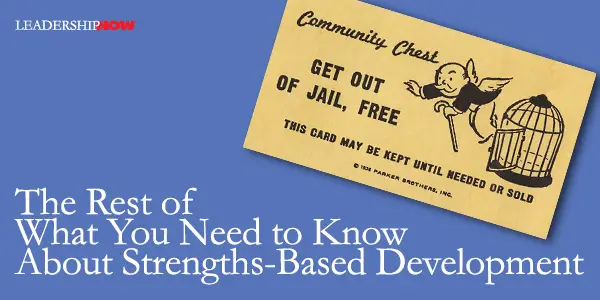 |
 |
07.13.09

The Rest of What You Need to Know About Strengths-Based Development
There is no arguing the fact that we all have various combinations of strengths in varying degrees. Maximizing the use of those strengths as we can, in the context we find ourselves in is advantageous to all involved. If you can carve out a place in the world that leverages your strengths that’s great, but the reality is that the world keeps changing and what is required of you to stay relevant – valuable – keeps changing too. You may need to develop a new strength and turn some of your weaknesses around. Then there is the question of whether or not your particular brand of strength is marketable. I may derive pleasure, feel actualized, and be in my zone by utilizing one of my strengths, but if it isn’t competitive with what others are doing with that same strength, well then, I’ll be out of work. Great hobby, but not a career (at least not at my current level of competence). Robert Kaiser has assembled fifteen authors in The Perils of Accentuating the Positive to help you get some perspective on the strengths movement. Kaiser writes that the point of the book “is not to dismiss strengths-based development.” It’s really a guide to make you a “savvier user of the strengths-based approach” and based on an understanding that “recognizes that both strengths and weaknesses have an appropriate place in learning and development.” In an interesting analysis by Korn/Ferry of 360 assessments of almost 2000 individuals, they found that most managers don’t have the leadership strengths that their companies need for them to have in order to be effective. The reality is, most people need to develop strengths that don’t come naturally to them. That means if you want to stay competitive – stand out from the crowd – you need to begin now to develop the strengths you don’t have now that are required for your long-term success. They bring out four ways to look at strengths: Your Personal Best: What comes naturally to you
If you plan to succeed by focusing on your strengths, make sure you do more than just discover and build on your strengths (your personal best). You will also need your strengths to stand out compared to your peers (competitive strengths). If you want to stand out among your peers and have a better chance for promotions, make sure your strengths set you apart from other also competitive peers (distinctively competitive strengths). Finally, you better hope that your five distinctive and competitive strengths include the ones that make a difference when it comes to long-term career success (competitive and aligned strengths). As we have stated here before, the overuse of a strength can be a weakness. In addition, USC professor Morgan McCall writes, “Strengths that have led to success, the very ones that advocates claim should be played to, can become weaknesses over time or in a new situation.” As our reality changes, we must also change. When we rely too much on our strengths we usually end up emphasizing them to the point where they become weaknesses and derail our career and relationships. I will say that Marcus Buckingham’s excellent film Trombone Player Wanted does speak eloquently to the tendency to obsess on the negative and systems designed to stifle the development of our strengths and create people that fit a predetermined mold. At the same time, as leaders, we do need to be working at placing people in positions where they can play to their strengths as much as possible. All too often people end up in positions that they never wanted or imagined for themselves and really have no business being in. Their effort can only be mediocre at best. We need to utilize our strengths and be proactive in our career and life decisions in an intelligent way. The tempering given to an obsessive strengths-only approach offered in The Perils of Accentuating the Positive helps you do just that.The bottom line is self awareness and adaptability. There are no shortcuts. Play to your strengths as you can but don’t be over-reliant on them. Develop new strengths as required. Manage your liabilities. Of Related Interest:
Posted by Michael McKinney at 01:35 PM
|
BUILD YOUR KNOWLEDGE
 

How to Do Your Start-Up Right STRAIGHT TALK FOR START-UPS 
Grow Your Leadership Skills NEW AND UPCOMING LEADERSHIP BOOKS 
Leadership Minute BITE-SIZE CONCEPTS YOU CAN CHEW ON 
Classic Leadership Books BOOKS TO READ BEFORE YOU LEAD |